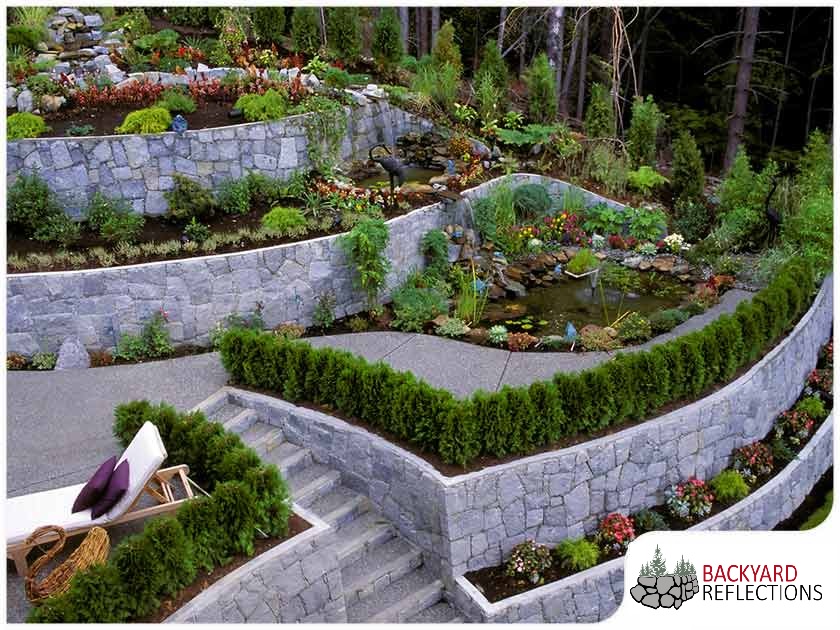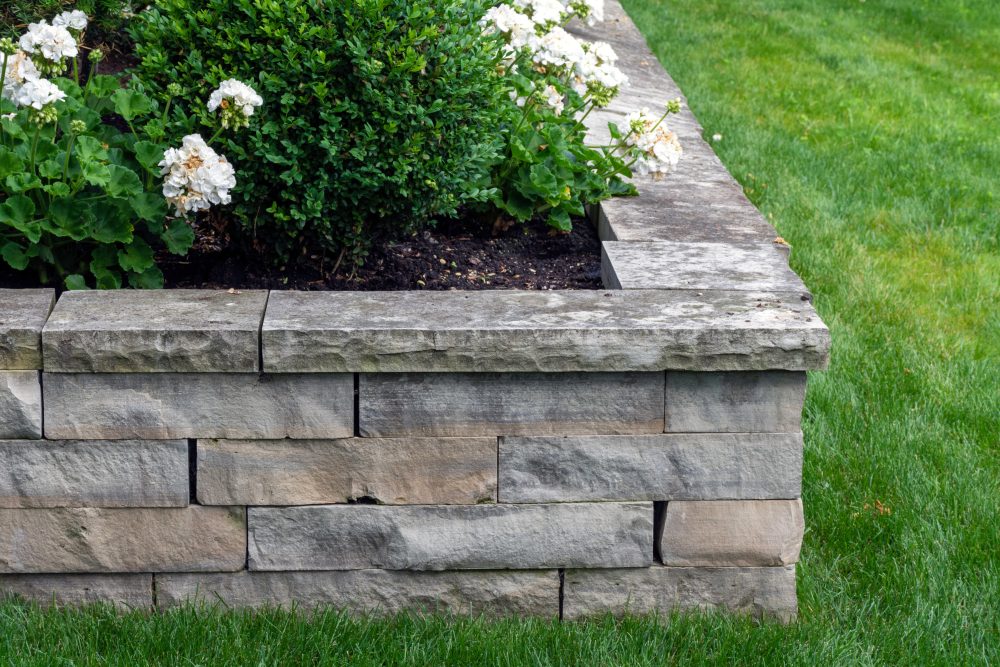Ten Must-Know insights about OKC Precision Retaining Walls every homeowner should know
Key Factors To Consider for Structure Efficient Retaining Walls in Your Yard
When you're thinking about building a maintaining wall surface in your yard, it's crucial to think regarding numerous essential variables. The wall's function, the products you'll use, and the details soil conditions can all influence its effectiveness and durability.
Recognizing the Purpose of Your Retaining Wall
When you consider building a maintaining wall surface, consider its main function: supporting dirt and preventing erosion. Retaining walls supply essential support for sloped landscapes, assisting to keep soil integrity. You'll discover they're crucial in locations where water drainage might otherwise get rid of dirt, bring about costly repair work and landscape damages.
By keeping back planet, these walls develop degree surface areas for yards, patios, or pathways. This not only improves your lawn's aesthetics however likewise advertises much better water drainage, lowering water merging in undesirable locations. If you're dealing with steep slopes, a well-constructed retaining wall can protect against landslides, ensuring safety for you and your property.
Ultimately, understanding the purpose of your retaining wall surface will certainly guide your design decisions and aid you develop a useful, long lasting framework that satisfies your needs. Take a moment to review your landscape; it'll pay off in the long run.
Picking the Right Products
When selecting materials for your retaining wall surface, you'll desire to take into consideration toughness, looks, and expense. Each element plays a vital function in ensuring your wall stands the test of time while looking wonderful and suitable your budget plan. Let's explore just how to make the most effective options for your project.
Product Durability Factors
Picking the appropriate products is crucial for the durability and efficiency of your retaining wall, given that their sturdiness directly affects the wall's capacity to withstand ecological anxieties. Begin by considering your regional climate; materials like concrete and rock resist moisture and temperature level changes well. If you live in a location susceptible to heavy rainfalls, choose for materials with good water drainage homes, like gravel or permeable blocks, to stop water accumulation.
Additionally, consider the dirt conditions on your home. Some materials do better in certain dirt kinds, so it is essential to match them appropriately. Be mindful of potential wear from parasites or erosion. Picking durable materials assurances your retaining wall surface stands strong, shielding your yard for many years ahead.
Aesthetic Design Choices
Resilient materials not just guarantee your retaining wall's architectural honesty yet additionally play a key function in its visual appeal. Do not neglect concerning the wall's shape-- bent walls can develop a softer look, while straight lines can really feel more structured. By very carefully choosing products that straighten with your visual vision, you'll improve your outdoor space while guaranteeing your wall stands solid versus the aspects.
Cost-Effectiveness Analysis
Picking the best materials for your retaining wall surface isn't just regarding aesthetic appeals; it's additionally important for your budget plan. When selecting products, take into consideration both upfront expenses and long-lasting durability.
Don't neglect to variable in maintenance costs. Some materials, like natural rock, can include beauty and require less upkeep, while others might need regular treatments
Eventually, evaluate the advantages and disadvantages of each choice against your budget plan and the wall's intended purpose. Investing intelligently in products currently can stop costly concerns down the road. Choose products that balance price and efficiency effectively.
Assessing Soil Conditions and Drainage
As you begin your task, reviewing dirt problems and drain is vital for the success of your retaining wall. Sandy dirt drains pipes well but lacks stability, while clay dirt can maintain wetness, leading to push on your wall surface.
Next, examine the slope of your backyard. If water naturally flows towards your wall, you'll require to implement a drainage remedy to stop erosion and stress buildup. Think about installing perforated pipelines or gravel backfill behind the wall to assist in drainage.
Finally, observe any close-by trees or vegetation; their roots can affect soil security. By understanding your soil problems and applying proper drain, you'll create a solid structure for your retaining wall that stands the test of time.
Abiding With Local Building Ordinance
Prior to you begin developing your retaining wall surface, you need to research study local laws to guarantee compliance. It's important to comprehend what allows you must acquire, as this can conserve you from pricey penalties or click over here needing to remodel your job. Taking these actions seriously will assist you develop a secure and effective structure.
Research Study Local Laws
Recognizing local regulations is important when planning your retaining wall project, especially since building codes Read Full Article can differ significantly by place. Start by talking to your local structure department or community to learn more about particular requirements. Look for standards on wall surface height, materials, water drainage systems, and architectural stability. Numerous areas have constraints on the sorts of materials you can use and just how high you can construct. You'll likewise wish to take into account the zoning regulations that may affect your task. Neglecting these policies can result in pricey fines or the need to remodel your work. By doing your study upfront, you can ensure your retaining wall fulfills all necessary codes and blends flawlessly right into your yard.
Obtain Needed Permits
Once you have actually looked into neighborhood regulations, the following action is to get the essential authorizations for your retaining wall surface job. They may require particular strategies or design evaluations, especially for larger walls. Safeguarding the appropriate authorizations can conserve you from expensive fines or having to dismantle your wall later on.

Preparation the Style and Aesthetic Appeal
As you begin planning the design and aesthetics of your retaining wall, take into consideration how it will balance with the bordering landscape. Consider the products you'll make use of-- rock, block, or concrete-- and just how they'll match your home's architecture and the all-natural elements in your backyard. Select colors and appearances that blend seamlessly with existing functions like patios, pathways, or gardens.
Following, imagine the wall's form and height. Rounded walls can soften a rigid landscape, while straight lines might share an extra contemporary appearance. Don't neglect to incorporate plants and plant around the wall for an all-natural touch; this can improve its charm and integrate it into the setting.
Finally, bear in mind performance. Your layout ought to not only be visually pleasing however also serve its objective efficiently. By attentively planning these aspects, you'll create a keeping wall surface that enhances your lawn's elegance while fulfilling its structural duty.
Calculating Elevation and Density Requirements
To develop a strong retaining wall surface, you need to precisely determine its elevation and density requirements based upon the soil conditions and the height of the incline it will certainly sustain. Start by examining the incline's angle and the sort of soil, as different soils put in differing quantities of pressure.
For walls over 4 feet high, take into consideration a thickness of at least 12 inches. If the wall is taller, boost the density proportionally to keep stability.
Next, calculate the height of the wall by determining the vertical distance it needs to maintain. For every single foot of elevation, you need to generally prepare for a density of one-third of the he has a good point wall surface's elevation.
Always keep in mind to represent extra aspects like water drainage and backfill, which can affect your wall's style. Appropriate calculations currently guarantee your retaining wall surface stands solid and lasts for years to find.
Maintenance and Durability Factors To Consider
While keeping your retaining wall surface may appear like a low concern, ignoring it can cause considerable problems in time. Regular evaluations are crucial; look for fractures, bulges, or any indicators of water damages. Attending to these problems early can save you from pricey repair services in the future.
Watch on water drainage systems, also. Blocked drains can create water to develop up, exerting stress on your wall surface and jeopardizing its security. Clear particles and guarantee correct flow to maintain long life.
You may also wish to assess sealing your wall surface to safeguard it from wetness and weathering. Depending upon the material, this might call for reapplication every few years.
Lastly, landscape design around your wall can sustain its integrity. Stay clear of planting huge trees nearby, as their origins can undermine the structure. With positive upkeep, your retaining wall can offer you well for years ahead.

Frequently Asked Inquiries
Can I Build a Retaining Wall by Myself, or Should I Employ a Specialist?
You can certainly construct a retaining wall on your own if you have the right devices and knowledge. Employing an expert warranties it's done correctly, especially for larger or even more intricate structures. Consider your ability level before making a decision.
What Are one of the most Usual Mistakes Made When Structure Retaining Walls?
When building retaining walls, you may ignore appropriate water drainage, miss using the right materials, or overlook reinforcement. These typical errors can cause architectural failing, so take your time and strategy meticulously to stay clear of concerns.
Just how Do I Know if My Retaining Wall Demands Support?
You'll recognize your retaining wall surface requires support if you see splits, leaning, or protruding. Look for water merging behind it or soil disintegration near the base. Address these signs promptly to avoid further damage.
What Plants Are Suitable for Landscaping Around a Retaining Wall?
When landscape design around a retaining wall, take into consideration making use of low-maintenance plants like succulents, decorative lawns, or sneaking ground covers - OKC Precision Retaining Walls. They'll prosper in those conditions and add beauty while preventing dirt disintegration around your wall
How Can I Prevent Disintegration Around My Retaining Wall?
To stop disintegration around your retaining wall, you can plant ground cover, usage compost, and install drainage systems. Frequently inspect for water buildup and readjust landscaping to redirect drainage far from the wall.